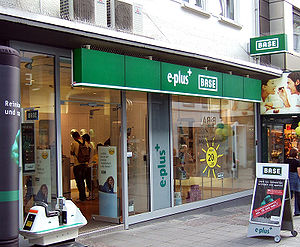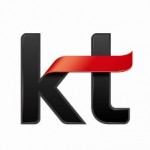- Image via Wikipedia
Germany is Europe’s largest economy and a key market for FON. People in Germany love FON and the Fonero community there is very active. However, FON’s WiFi footprint in Germany is smaller than in other European countries, like the UK and France, where our Telco partners have helped us grow. Fon´s partnership with E-Plus, is about to change that. Today FON is announcing a partnership with the E-Plus group in Germany. With more than 18 million subscribers and annual revenues of 3.2 billion Euros, the E-Plus group is Germany’s third largest mobile operator. E-Plus is part of KPN group and is considered an innovator in the German mobile Telco market. E-Plus will help the FON community grow in Germany with a planned series of joint activities starting this year. For example, E-Plus will install Foneras in more than 300 E-Plus stores in prime locations throughout Germany. Together, FON and E-plus will target cafes and other public places where we will install FON Spots as part of the “City FON” initiative – similar to the “Chueca WiFi” and “Shoreditch” density projects in Spain and England. E-Plus will promote FON to their 18 Million subscribers and will help us to encourage them to become Foneros. E-Plus customers who register for the collaboration will be eligible for discounts on Foneras and will get free trial access to the FON WiFi network and once they installed their Fon routers they will be able to roam the world for free connecting to other Foneros.
The FON E-Plus partnership is great for two reasons. E-Plus has great marketing power that will increase FON awareness and help the German FON community grow faster. E-Plus is the first pure mobile operator to partner with FON. Initially journalists and bloggers had argued that Fon would be stopped by fixed and mobile operators. Some of these experts confused Fon with a P2P telco network. But the difference here is that while P2P networks destroy value for the music labels, Fon increases value to telcos. How? Well, as our partnership with BT, known as BTfon, and others have shown, Fon generates value both for consumers and telcos. For consumers the proposition is clear, you share some extra, limited, bandwidth at home in a secure way with a second SSID or WiFi signal, and in return you roam the world for free. For fixed telcos, Fon increases customer loyalty, reduces churn, reduces customer acquisition costs. Fon enabled fixed operators can also resist price decreases as their customers have WiFi at home and everywhere else.
Now, for mobile operators, the one big benefit of Fon is reduced capex (investment in the network). 3G is a phenomenal service because of its coverage and frankly no matter how many hotspots we put, Fon will never compete with 3G in terms of coverage. So customers who want to have Internet in a car or to find it no matter where they are will always have to use 3G. But when there is WiFi, there are now tons of mobile phones that have a WiFi option, including the iPhone, Nokias, Samsungs, HTCs and others. And use of WiFi is advantageous to operators because: customers are happy with the speeds, they pay their monthly service anyway and they don´t use the much costlier 3G infrastructure. 3G is great for operators for voice and light data. But when people start downloading 300MB movies and TV series to watch in their mobile devices, operators either have to charge for that bandwidth making movies expensive, or prefer that people use WiFi. Moreover, some of the most popular gadgets in the world, such as the Nintendo DS, the PSP and so on, only come with WiFi. In this way, E-Plus can now service its customers on all of their connected devices.
All in all, this proves a point I have been making for a long time. FON and Mobile Telcos make great partners. WiFi is a complement to 3G. Moreover, we are very excited that this announcement coincides with the launch of the Fonera 2.0. The Fonera 2.0 has just been introduced in Germany (not yet in the UK) and it is a router that not only gives you free roaming but also manages your transfers to the Internet. Fonera 2.0 on its own sends your videos to Youtube, your pictures to Flickr, downloads your files from Rapidshare or Megaupload, or Bittorrent (disclosure this app is working poorly at the moment) and it is especially good for converting 3G signal from HSDPA modules to WiFi.
If you would like to interview me about this announcement please use the contact form of this blog and I will be happy to answer questions.

Follow Martin Varsavsky on Twitter: twitter.com/martinvars
Related Posts
No Comments
steven leeman on June 2, 2009 ·
Great news!!!
I hope this will also propagate to Simyo/Ay Yaldiz active in other countries ?
BTW this is not unique… in 2007 FON & Debitel worked together as well… but Debitel got sold by KPN; the foneras active in the shops are since then “greyed” out and somewhere in central storage 🙁
Btw the Fonera 2.0 only supports Huawei 3G Usb sticks… it does not support other brands(eg Option) used by eg Vodaphone, T-Mobile, …
Mariano Marcos on June 4, 2009 ·
I’m focusing on smaller players for Vidactio (a solution for bringing the interactivity of the web to video content) and then grab the attention of the big players. I guess our size recommends that. And I guess that Fon’s size recommends the opposite !
18 million potential foneras is a great deal !
Above all if the conversion into customers is…. I don’t know your forecast…. over 20% ??
Good luck (and work) in your future steps.
Martin Varsavsky on June 4, 2009 ·
Fon has found that the only way we grow very well is in countries where we team up with big telcos. We have to admit that user generated infrastructure took us 30% of the way. The remaining 70% is telco partnerships. This is a good lesson for start ups, collaboration with giants is slow but eventually it pays off. There has to be a reason as to why they are giants 🙂
Leave a Comment
You must be logged in to post a comment.






Mariano Marcos on June 2, 2009 ·
Congratulations.
Any future movements with other KPN companies like simyo in Spain?
Martin Varsavsky on June 2, 2009 ·
Well Symio has around 300K customers I believe, a good effort but Fon is focusing on the larger deals first. Having this we welcome Symio and making a deal with them. Coincidentally we have some very able former Fon employees work at Symio in Spain.